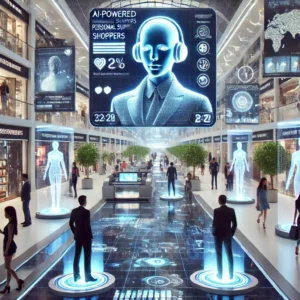
Imagine walking into your favorite e-store and having your shopping list read out, your queries answered, and your purchases confirmed—all without touching a screen. Yes, voice commerce is here, reshaping traditional e-commerce in ways that are as surprising as they are inevitable. From government initiatives to research breakthroughs, political debates to celebrity endorsements, and from generational divides to global business forecasts, the impact of voice-activated buying is multi-dimensional and ever-evolving.
The Emergence of Voice-Activated Buying
Not long ago, the idea of shopping solely through voice commands might have sounded like science fiction. Yet, in the blink of an eye, our digital world has embraced voice commerce, revolutionizing how we interact with e-stores. This seismic shift in consumer behavior stems from rapid advancements in natural language processing (NLP) and artificial intelligence (AI). Today, voice assistants like Alexa, Google Assistant, and Siri do more than set reminders—they are becoming personal shopping concierges.
In a landscape where efficiency and immediacy are prized, voice commerce offers a frictionless shopping experience. Instead of fumbling with keyboards or tapping through endless product pages, customers can simply speak their desires. And while the technology is evolving at breakneck speed, industry experts and research labs are continuously enhancing voice recognition accuracy and response time, ensuring that even the most colloquial commands are understood and executed correctly.
This trend isn’t just a passing fad; it’s a technological revolution with far-reaching implications. As e-commerce giants adapt to this change, smaller online retailers are also scrambling to integrate voice-activated features into their platforms. Learn more about emerging tech trends here.
Government and Political Perspectives
Interestingly, the march toward voice commerce is receiving nods from governmental bodies worldwide. In several countries, digital transformation initiatives are being prioritized as a part of national strategies. For instance, recent policy updates in the United States and European Union have focused on boosting AI research, data privacy, and cybersecurity—all critical elements for the secure expansion of voice commerce.
Political debates occasionally stir around issues like data sovereignty and privacy, given that voice-activated systems continuously collect personal data. Legislators are grappling with how best to protect consumer interests without stifling innovation. In a recent congressional hearing, policymakers emphasized the need for robust encryption and strict regulations to safeguard voice data, ensuring that technology doesn’t outpace privacy protections.
Government-backed research projects have also emerged, with agencies like the National Institute of Standards and Technology (NIST) and similar bodies in Europe collaborating with tech companies. Their goal? To set global standards that ensure safe, secure, and efficient voice commerce operations. This intricate dance between regulation and innovation is crucial, balancing progress with public trust.
Scientific Research and Laboratory Innovations
Diving into the realm of research, numerous academic institutions and private research labs are busy decoding the complexities of voice commerce. Esteemed scientists at institutions like MIT and Stanford are exploring how deep learning algorithms can refine voice recognition, ensuring that even nuanced accents and dialects are accurately interpreted. Their findings, often published in renowned journals, shed light on the subtle improvements needed to perfect these systems.
Researchers have also been experimenting with contextual awareness in voice assistants, aiming to create systems that not only understand words but also the context behind them. This research is paving the way for voice commerce platforms that can handle multi-step transactions, process returns, and even offer personalized product recommendations based on historical buying behavior.
In a somewhat fragmented yet exciting stream of innovation, labs across the globe are collaborating on international projects. These collaborations, sometimes appearing disjointed in their funding and focus, collectively propel the voice commerce revolution forward. For additional insights into academic research, check out the latest findings on MIT Technology Review.
Celebrity Endorsements and Public Perception
It’s not just tech experts and policymakers who are buzzing about voice commerce—celebrities are joining the conversation too. High-profile figures in entertainment and business have taken to social media to express their excitement. For instance, a few months ago, a renowned actor quipped, “If my voice can buy me a latte before I even get out of bed, imagine what it can do for the future of retail!” Such endorsements not only boost public interest but also lend an air of credibility to voice-activated shopping systems.
Public sentiment, however, is a mixed bag. Some people revel in the convenience, while others express concerns over privacy and the potential loss of personal touch in customer service. Social media platforms are abuzz with lively debates, as everyday users share anecdotes—sometimes humorous, occasionally frustrating—about their experiences with voice commerce. This lively discourse underscores how deeply integrated voice technology is becoming in everyday life.
Even celebrities, with their vast influence, have voiced concerns over the rapid pace of change. They remind us, albeit in a lighthearted manner, that while innovation is exhilarating, it also calls for responsible implementation and regulation.
Generational Perspectives: Youth vs. Older Adults
The story of voice commerce is as much about generational differences as it is about technology. Young consumers, who grew up in a digital-first world, are quick to adopt new tech with minimal resistance. For many in their 20s and 30s, speaking to a device is as natural as sending a text message. This demographic appreciates the efficiency and novelty of voice shopping, often citing how it saves time during their busy schedules.
On the flip side, older adults tend to approach voice commerce with a blend of curiosity and skepticism. Some express concerns over the accuracy of voice recognition or worry about the loss of human interaction. Yet, as more seniors become digitally literate, many are pleasantly surprised by the convenience that voice commerce offers. Anecdotes from community centers reveal that even those who once doubted the reliability of technology are now exploring voice assistants to order groceries or book appointments.
Interestingly, family gatherings have turned into informal tech lessons, where younger family members guide their elders through the quirks of voice-operated systems. This intergenerational exchange not only bridges the digital divide but also reinforces how voice commerce is weaving itself into the fabric of society.
Global Business Impact and Revenue Growth
The economic ramifications of the voice commerce revolution are staggering. Global revenues from voice-activated shopping are projected to soar, driven by rapid adoption across multiple markets. Major retailers are investing heavily in refining their voice interfaces, seeing it as a gateway to increased consumer engagement and higher sales conversion rates.
In recent reports, industry analysts from firms like Gartner and Statista have noted that businesses integrating voice commerce features have seen a marked improvement in customer retention and average order values. For example, companies in the tech and retail sectors are now reporting that voice-driven purchases contribute to an estimated 20-30% of their online sales—a statistic that is prompting even traditional retailers to rethink their digital strategies.
This explosive growth is not limited to a single region. Markets in North America, Europe, and Asia are experiencing a surge in voice commerce adoption. Global business leaders are even organizing international summits to discuss standardizing voice technology, ensuring that voice commerce remains accessible and secure worldwide. Curious readers might find further details on revenue trends in voice commerce at Gartner’s official website.
Challenges and Considerations in Voice Commerce
As thrilling as the future of voice commerce appears, it’s not without its challenges. Privacy remains a hot-button issue. With voice assistants constantly listening for commands, the potential for misuse of personal data is a concern that both consumers and regulators grapple with. The inadvertent recording of sensitive information or even background conversations poses risks that companies must diligently address.
Security, too, is a pressing challenge. Cybercriminals are always on the lookout for vulnerabilities, and as voice commerce systems become more sophisticated, so too do the threats they face. Industry insiders admit that while encryption and advanced security protocols have improved, there is still a lingering uncertainty about long-term data protection.
In a rather meandering reflection, one might consider that technology—no matter how advanced—often comes with a double-edged sword. The balance between innovation and privacy is delicate, and even slight missteps can erode consumer trust. For those interested in the nuances of tech security, NIST guidelines on cybersecurity offer a deeper dive into the subject.
Future Trends and the Road Ahead
Looking forward, the horizon of voice commerce is both promising and peppered with uncertainties. Experts predict that voice-activated shopping will become even more integrated with other emerging technologies such as augmented reality (AR) and the Internet of Things (IoT). Imagine a scenario where your smart refrigerator automatically orders groceries when supplies run low, all activated by a simple voice command!
Yet, the road ahead is not entirely smooth. The integration of voice commerce with other tech realms will require overcoming technical glitches, consumer mistrust, and regulatory hurdles. But the trajectory seems clear: as long as innovation continues unabated, voice commerce is poised to redefine the retail landscape. Many industry pundits believe that we are only at the tip of the iceberg, with a future that promises even more seamless and personalized shopping experiences.
Anecdotally, some entrepreneurs have even compared the current phase of voice commerce to the early days of the internet—full of potential but fraught with unforeseen challenges. In a world where unpredictability is the only constant, this blend of excitement and caution might just be the perfect recipe for progress.
Frequently Asked Questions
Q1: What is voice commerce?
A: Voice commerce involves using voice-activated technology to browse, order, and purchase products online. This method leverages AI and NLP to provide a hands-free shopping experience.
Q2: How secure is voice commerce?
A: While voice commerce systems employ robust encryption and security measures, concerns remain regarding data privacy and potential hacking. Continuous improvements and strict regulations aim to mitigate these risks.
Q3: Are there benefits for both young and older consumers?
A: Yes. Younger users appreciate the speed and convenience of voice commands, while many older adults find the simplicity of voice interfaces appealing, especially as they become more digitally literate.
Q4: How are governments influencing voice commerce?
A: Governments worldwide are investing in digital transformation initiatives and enacting policies to protect consumer data while fostering innovation in voice-activated technology.
Q5: What do global businesses expect from voice commerce?
A: Major retailers project increased sales, improved customer engagement, and higher conversion rates through the integration of voice commerce, driving significant revenue growth on a global scale.
A Patchwork of Perspectives: A Concluding Reflection
What stands out in this unfolding narrative of voice commerce is not merely the technological leap—it’s the interplay of diverse voices and visions. From the meticulous notes of government regulators and the robust debates in political circles to the enthusiastic endorsements of celebrities and the candid opinions of everyday consumers, this revolution is as much a social evolution as it is a technological one.
There are moments when the pace of change seems almost overwhelming, and yes, sometimes it feels like we’re navigating uncharted territory with the occasional hiccup. Yet, in those very imperfections, the true charm of innovation resides. The blend of rigorous scientific research, public curiosity, and pragmatic business strategies underscores a dynamic ecosystem that is, at times, unpredictable but always forward-moving.
If you’re intrigued by the transformative power of voice commerce or if you simply want to stay ahead of the curve in digital retail trends, consider diving deeper into our tech insights section and signing up for our newsletter. After all, in a world that speaks—and listens—in voices, every word counts.




